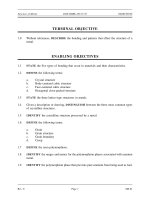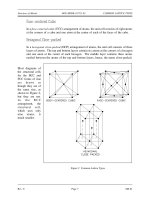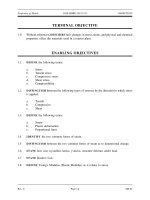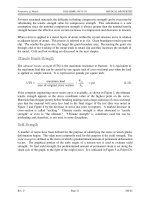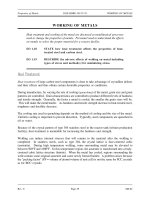Material Science_ Vol 1 of 2 - US DOE (1993) Episode 6 pdf
Bạn đang xem bản rút gọn của tài liệu. Xem và tải ngay bản đầy đủ của tài liệu tại đây (140.03 KB, 10 trang )
Properties of Metals DOE-HDBK-1017/1-93 OBJECTIVES
ENABLING OBJECTIVES (Cont.)
1.16 DESCRIBE the effects on ductility caused by:
a. Temperature changes
b. Irradiation
c. Cold working
1.17 IDENTIFY the reactor plant application for which high ductility is desirable.
1.18 STATE how heat treatment effects the properties of heat-treated steel and carbon steel.
1.19 DESCRIBE the adverse effects of welding on metal including types of stress and
method(s) for minimizing stress.
1.20 STATE the reason that galvanic corrosion is a concern in design and material selection.
1.21 DESCRIBE hydrogen embrittlement including the two required conditions and the
formation process.
1.22 IDENTIFY why zircaloy-4 is less susceptible to hydrogen embrittlement than zircaloy-2.
Rev. 0 Page ix MS-02
OBJECTIVES DOE-HDBK-1017/1-93 Properties of Metals
Intentionally Left Blank
MS-02 Page x Rev. 0
Properties of Metals DOE-HDBK-1017/1-93 STRESS
STRESS
Any component, no matter how simple or complex, has to transmit or sustain a
mechanical load of some sort. The load may be one of the following types: a
load that is applied steadily ("dead" load); a load that fluctuates, with slow or fast
changes in magnitude ("live" load); a load that is applied suddenly (shock load);
or a load due to impact in some form. Stress is a form of load that may be
applied to a component. Personnel need to be aware how stress may be applied
and how it effects the component.
EO 1.1 DEFINE the following terms:
a. Stress
b. Tensile stress
c. Compressive stress
d. Shear stress
e. Compressibility
EO 1.2 DISTINGUISH between the following types of stresses by the
direction in which stress is applied.
a. Tensile
b. Compressive
c. Shear
When a metal is subjected to a load (force), it is distorted or deformed, no matter how strong
the metal or light the load. If the load is small, the distortion will probably disappear when the
load is removed. The intensity, or degree, of distortion is known as strain. If the distortion
disappears and the metal returns to its original dimensions upon removal of the load, the strain
is called elastic strain. If the distortion disappears and the metal remains distorted, the strain
type is called plastic strain. Strain will be discussed in more detail in the next chapter.
When a load is applied to metal, the atomic structure itself is strained, being compressed,
warped or extended in the process. The atoms comprising a metal are arranged in a certain
geometric pattern, specific for that particular metal or alloy, and are maintained in that pattern
by interatomic forces. When so arranged, the atoms are in their state of minimum energy and
tend to remain in that arrangement. Work must be done on the metal (that is, energy must be
added) to distort the atomic pattern. (Work is equal to force times the distance the force
moves.)
Rev. 0 Page 1 MS-02
STRESS DOE-HDBK-1017/1-93 Properties of Metals
Stress is the internal resistance, or counterfource, of a material to the distorting effects of an
external force or load. These counterforces tend to return the atoms to their normal positions.
The total resistance developed is equal to the external load. This resistance is known as stress.
Although it is impossible to measure the intensity of this stress, the external load and the area
to which it is applied can be measured. Stress (σ) can be equated to the load per unit area or
the force (F) applied per cross-sectional area (A) perpendicular to the force as shown in
Equation (2-1).
(2-1)Stress σ
F
A
where:
σ = stress (psi or lbs of force per in.
2
)
F = applied force (lbs of force per in.
2
)
A = cross-sectional area (in.
2
)
Stresses occur in any material that is subject to a load or any applied force. There are many
types of stresses, but they can all be generally classified in one of six categories: residual
stresses, structural stresses, pressure stresses, flow stresses, thermal stresses, and fatigue
stresses.
Residual stresses are due to the manufacturing processes that leave stresses in a
material. Welding leaves residual stresses in the metals welded. Stresses associated
with welding are further discussed later in this module.
Structural stresses are stresses produced in structural members because of the weights
they support. The weights provide the loadings. These stresses are found in building
foundations and frameworks, as well as in machinery parts.
MS-02 Page 2 Rev. 0
Properties of Metals DOE-HDBK-1017/1-93 STRESS
Pressure stresses are stresses induced in vessels containing pressurized materials. The
loading is provided by the same force producing the pressure. In a reactor facility, the
reactor vessel is a prime example of a pressure vessel.
Flow stresses occur when a mass of flowing fluid induces a dynamic pressure on a
conduit wall. The force of the fluid striking the wall acts as the load. This type of
stress may be applied in an unsteady fashion when flow rates fluctuate. Water hammer
is an example of a transient flow stress.
Thermal stresses exist whenever temperature gradients are present in a material.
Different temperatures produce different expansions and subject materials to internal
stress. This type of stress is particularly noticeable in mechanisms operating at high
temperatures that are cooled by a cold fluid. Thermal stress is further discussed in
Module 3.
Fatigue stresses are due to cyclic application of a stress. The stresses could be due to
vibration or thermal cycling. Fatigue stresses are further discussed in Module 4.
The importance of all stresses is increased when the materials supporting them are flawed.
Flaws tend to add additional stress to a material. Also, when loadings are cyclic or unsteady,
stresses can effect a material more severely. The additional stresses associated with flaws and
cyclic loading may exceed the stress necessary for a material to fail.
Stress intensity within the body of a component is expressed as one of three basic types of
internal load. They are known as tensile, compressive, and shear. Figure 1 illustrates the
different types of stress. Mathematically, there are only two types of internal load because
tensile and compressive stress may be regarded as the positive and negative versions of the
same type of normal loading.
Rev. 0 Page 3 MS-02
STRESS DOE-HDBK-1017/1-93 Properties of Metals
However, in mechanical design, the response of components to the two conditions can be so
different that it is better, and safer, to regard them as separate types.
As illustrated in Figure 1, the plane of a tensile or compressive stress lies perpendicular to the
axis of operation of the force from which it originates. The plane of a shear stress lies in the
plane of the force system from which it originates. It is essential to keep these differences
quite clear both in mind and mode of expression.
Figure 1 Types of Applied Stress
Tensile stress is that type of stress in which the two sections of material on either side
of a stress plane tend to pull apart or elongate as illustrated in Figure 1(a).
Compressive stress is the reverse of tensile stress. Adjacent parts of the material tend
to press against each other through a typical stress plane as illustrated in Figure 1(b).
Shear stress exists when two parts of a material tend to slide across each other in any
typical plane of shear upon application of force parallel to that plane as illustrated in
Figure 1(c).
MS-02 Page 4 Rev. 0
Properties of Metals DOE-HDBK-1017/1-93 STRESS
Assessment of mechanical properties is made by addressing the three basic stress types.
Because tensile and compressive loads produce stresses that act across a plane, in a direction
perpendicular (normal) to the plane, tensile and compressive stresses are called normal stresses.
The shorthand designations are as follows.
For tensile stresses: "+S
N
" (or "S
N"
) or "σ" (sigma)
For compressive stresses: "-S
N
" or "-σ" (minus sigma)
The ability of a material to react to compressive stress or pressure is called compressibility.
For example, metals and liquids are incompressible, but gases and vapors are compressible.
The shear stress is equal to the force divided by the area of the face parallel to the direction
in which the force acts, as shown in Figure 1(c).
Two types of stress can be present simultaneously in one plane, provided that one of the
stresses is shear stress. Under certain conditions, different basic stress type combinations may
be simultaneously present in the material. An example would be a reactor vessel during
operation. The wall has tensile stress at various locations due to the temperature and pressure
of the fluid acting on the wall. Compressive stress is applied from the outside at other
locations on the wall due to outside pressure, temperature, and constriction of the supports
associated with the vessel. In this situation, the tensile and compressive stresses are considered
principal stresses. If present, shear stress will act at a 90° angle to the principal stress.
Rev. 0 Page 5 MS-02
STRESS DOE-HDBK-1017/1-93 Properties of Metals
The important information in this chapter is summarized below.
Stress is the internal resistance of a material to the distorting effects of an
external force or load.
Stress σ
F
A
Three types of stress
Tensile stress is the type of stress in which the two sections of material
on either side of a stress plane tend to pull apart or elongate.
Compressive stress is the reverse of tensile stress. Adjacent parts of the
material tend to press against each other.
Shear stress exists when two parts of a material tend to slide across each
other upon application of force parallel to that plane.
Compressibility is the ability of a material to react to compressive stress or
pressure.
MS-02 Page 6 Rev. 0
Properties of Metals DOE-HDBK-1017/1-93 STRAIN
STRAIN
When stress is present strain will be involved also. The two types of strain will
be discussed in this chapter. Personnel need to be aware how strain may be
applied and how it affects the component.
EO 1.3 DEFINE the following terms:
a. Strain
b. Plastic deformation
c. Proportional limit
EO 1.4 IDENTIFY the two common forms of strain.
EO 1.5 DISTINGUISH between the two common forms of strain
according to dimensional change.
EO 1.6 STATE how iron crystalline lattice structures,
γγ and αα, deform
under load.
In the use of metal for mechanical engineering purposes, a given state of stress usually exists in
a considerable volume of the material. Reaction of the atomic structure will manifest itself on
a macroscopic scale. Therefore, whenever a stress (no matter how small) is applied to a metal,
a proportional dimensional change or distortion must take place.
Such a proportional dimensional change (intensity or degree of the distortion) is called strain and
is measured as the total elongation per unit length of material due to some applied stress.
Equation 2-2 illustrates this proportion or distortion.
(2-2)
Strain ε
δ
L
where:
ε = strain (in./in.)
δ = total elongation (in.)
L = original length (in.)
Rev. 0 Page 7 MS-02
STRAIN DOE-HDBK-1017/1-93 Properties of Metals
Strain may take two forms; elastic strain and plastic deformation.
Elastic strain is a transitory dimensional change that exists only while the initiating stress
is applied and disappears immediately upon removal of the stress. Elastic strain is also
called elastic deformation. The applied stresses cause the atoms in a crystal to move from
their equilibrium position. All the atoms are displaced the same amount and still maintain
their relative geometry. When the stresses are removed, all the atoms return to their
original positions and no permanent deformation occurs.
Plastic deformation (or plastic strain) is a dimensional change that does not disappear
when the initiating stress is removed. It is usually accompanied by some elastic strain.
The phenomenon of elastic strain and plastic deformation in a material are called elasticity and
plasticity, respectively.
At room temperature, most metals have some elasticity, which manifests itself as soon as the
slightest stress is applied. Usually, they also possess some plasticity, but this may not become
apparent until the stress has been raised appreciably. The magnitude of plastic strain, when it
does appear, is likely to be much greater than that of the elastic strain for a given stress
increment. Metals are likely to exhibit less elasticity and more plasticity at elevated temperatures.
A few pure unalloyed metals (notably aluminum, copper and gold) show little, if any, elasticity
when stressed in the annealed (heated and then cooled slowly to prevent brittleness) condition
at room temperature, but do exhibit marked plasticity. Some unalloyed metals and many alloys
have marked elasticity at room temperature, but no plasticity.
The state of stress just before plastic strain begins to appear is known as the proportional limit,
or elastic limit, and is defined by the stress level and the corresponding value of elastic strain.
The proportional limit is expressed in pounds per square inch. For load intensities beyond the
proportional limit, the deformation consists of both elastic and plastic strains.
As mentioned previously in this chapter, strain measures the proportional dimensional change
with no load applied. Such values of strain are easily determined and only cease to be
sufficiently accurate when plastic strain becomes dominant.
MS-02 Page 8 Rev. 0


